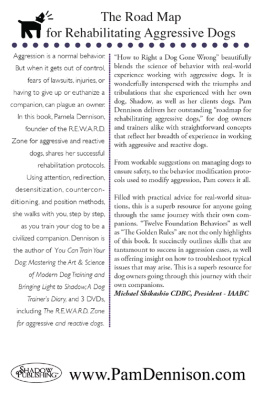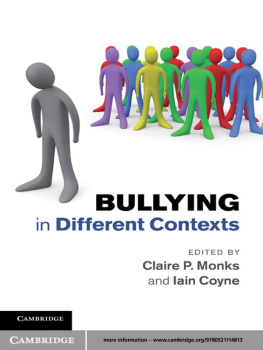Published in 2012 by The Rosen Publishing Group, Inc.
29 East 21st Street, New York, NY 10010
Copyright 2012 by The Rosen Publishing Group, Inc.
First Edition
All rights reserved. No part of this book may be reproduced in any form without permission in writing from the publisher, except by a reviewer.
Library of Congress Cataloging-in-Publication Data
Navarre, Sam.
Masculinity, bullying, and aggression: a guy's guide/Sam Navarre. 1st ed.
p. cm.(A young man's guide to contemporary issues) Includes bibliographical references and index.
ISBN 978-1-4488-5525-4 (library binding)
1 . MasculinityJuvenile literature.
2. BullyingJuvenile literature.
3. AggressivenessJuvenile literature. I. Title.
BF692.5.N38 2012 155.5'32dc22
2011013572
Manufactured in the United States of America
CPSIA Compliance Information: Batch #W12YA: For further information, contact Rosen Publishing, New York, New York, at 1-800-237-9932.
CONTENTS
INTRODUCTION
A ll boys will experience it at some point: they start to notice hair on their upper lip. Their voices drop. Their muscles develop. They grow hair on their chests. Slowly but surely, their bodies mature. But physical changes are only one part of growing up. Becoming a man means much more than that.
How does a boy know that he's finally become a man? Boys come of age in different ways in different cultures. Jewish boys around the world must prove that they ca read from the Torah and interpret it in front of their congregation. In the Hamar tribe in Ethiopia, a boy must run back and forth across the backs of a line of cattle to officially enter manhood. On Pentecost Island in the South Pacific, men prove their bravery by "land diving" leaping off a wooden platform as tall as 100 feet (30.5 meters), with only a vine tied to one leg.

A boy reads from the Torah, or Hebrew Scripture, athis Bar Mitzvah. In this Jewish coming-of-age ritual,thirteen-year-old boys take their place as men in thecongregation.
In North American culture, there is no single mark to measure the transition to manhood. In fact, we don't even share a single definition of manhood. Some North Americans believe that being a man means being strong and silent, never feeling any pain, disappointment, or sadness. Others insist that real men are strong enough to show their emotions. Many people maintain that a man must be physically tough and aggressive, ready to fight for respect and honor. Others disagree, saying that a real man never has to resort to violence.
Being a man in North America might mean never crying, or crying freely; being powerful, or being sensitive; pushing yourself, or acting like a slob; being chivalrous, or being crass; or acting like a perfect gentleman, or acting out as a bad boy. With so many mixed messages, it's a wonder that any guy figures out how to become a man.
But if adults in our culture have many different definitions of manhood, most boys seem to agree how a boy should act. There's an unspoken set of rules about how they should act, look, sound, and treat others. Dr. William S. Pollack, author of the book Real Boys: Rescuing Our Sons from the Myths of Boyhood, calls this set of rules the Boy Code.
All boys want to feel like they are manly. And most boys go far out of their way to prove their masculinity. This is a natural and normal part of growing up. But sometimes boys go a little overboard in their efforts to uphold the Boy Code. For instance, some boys try so hard to appear tough that they actually become violent.
According to the National Center for Education Statistics, 31 percent of students in grades nine to twelve reported being in a physical fight at least once in 2009. In addition, 4 percent of males said they had been in a fight twelve or more times, compared to 1 percent of females.
There are also other reasons why boys get aggressive and violent. Some boys live in violent neighborhoods, where they feel they need to defend themselves in order to survive. Other boys use violence because they don't know how else to express themselves. Our society pressures men to stifle their negative emotions in hopes that they will simply go away. But when you ignore strong feelings like sadness, anger, and shame, you only make them stronger. Sometimes these unexpressed feelings boil over and drive boys to become violent.
Boys need to realize that they can be safe and strong without resorting to violence. Perhaps more important, boys need to realize that all violence comes from a place of pain and that when they hurt others, they are also hurting themselves.
This book intends to point out ways for boys to break free of dependence on violence, to draw strength from their emotions, and to define for themselves what it means to be a man.
You will become a man one day. But the kind of man you will become is up to you.
AGGRESSION: THE MEASURE OF A MAN?
F eelings of aggression and competition are normal for boys. Unfortunately, our culture sometimes sends the signal that men are only men if they act aggressively if they intimidate and threaten others, fight, or express their emotions through violence.
THE MEASURE OF A MAN
Our culture has no single definition of manhood, no rite that boys must go through in order to become men. However, North American boys have some pretty strong ideas about what is manly and what is not.
Imagine that we draw a box. Inside, we'll list all of the personality traits and physical attributes that a man is supposed to have according to the Boy Code. We'll write everything a man is not supposed to be outside the box.
How is a man supposed to look? Inside the box we would list "muscular," "strong," "athletic," and "handsome." Outside the box we would write such words as "frail," "effeminate," and "bookish."

In any culture, boys must prove that they are worthy to be considered men. In todays America, boys must also decide what being a man means to them.
How is a man supposed to sound? Inside the box we might write "low voice" and "commanding." What is he supposed to talk about? We might list "sports," "politics," or "business" inside the box. Outside the box we might write "feelings," "disappointments," and "fears." What is a male supposed to do for fun? Inside the box we might put "football." Outside the box we might put "ballet."

Dance can demand just as much strength, athleticism, discipline, and competitive spirit as sports. For many boys, pursuing the goal of becoming a dancer takes real guts and determination.
According to our culture, a man is supposed to be brave, responsible, energetic, strong, and popular with the ladies. He is not supposed to be weak, effeminate, a sissy, or a crybaby.
















